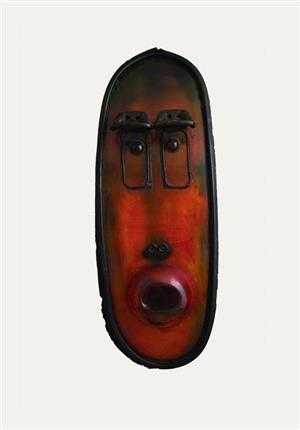About Changiz Shahvagh
Changiz Shahvagh, a painter and sculptor, was one of the pioneers and influential figures of modern Iranian art. As a child, he immigrated from Baku to Tehran with his family. He entered the Tehran Academy of Fine Arts in 1952 and began studying pottery and ceramics. After finishing high school in 1957, he joined the Faculty of Fine Arts in Tehran and studied painting. Shahvagh entered the professional arena as a fresh artist by presenting his early works alongside the works of Kouros Salahshour in the Asthetic Gallery of Tehran. In 1959, he exhibited his sculptures for the first time in Tehran's Abbasi Gallery. In the following years of his activity, he continuously exhibited his paintings and sculptures in Iran and international art circles.
Part of the importance of Shahvagh in his institutional activities is that he provided suitable bases for the growth and development of modern art. He actively held five Tehran Biennials and established two galleries, Takht Jamshed and Saba. His participation in the third and fourth biennials was successful and brought him the badge of honor, and he moved to Europe after receiving a grant to travel to Italy and spent some time at the House of Arts in Paris. Also, in the last years of his life, he taught at the Faculty of Art and Architecture of Islamic Azad University. He also cooperated with the Ministry of Culture and Guidance in management areas.
After several decades of scattered experience in portrait art, Shahvagh turned to absolute abstraction. His abstract approach was often accompanied by a violent and unbridled expression of emotion. In his paintings and sculptures, he used different materials and emphasized the variety of texture of the surfaces and the rhythm of the lines. Color played a secondary role in his compositions and was mainly mixed with the gender of the paint. Works of this artist are kept in the Tehran Museum of Contemporary Art and Georges Pompidou in Paris.
Part of the importance of Shahvagh in his institutional activities is that he provided suitable bases for the growth and development of modern art. He actively held five Tehran Biennials and established two galleries, Takht Jamshed and Saba. His participation in the third and fourth biennials was successful and brought him the badge of honor, and he moved to Europe after receiving a grant to travel to Italy and spent some time at the House of Arts in Paris. Also, in the last years of his life, he taught at the Faculty of Art and Architecture of Islamic Azad University. He also cooperated with the Ministry of Culture and Guidance in management areas.
After several decades of scattered experience in portrait art, Shahvagh turned to absolute abstraction. His abstract approach was often accompanied by a violent and unbridled expression of emotion. In his paintings and sculptures, he used different materials and emphasized the variety of texture of the surfaces and the rhythm of the lines. Color played a secondary role in his compositions and was mainly mixed with the gender of the paint. Works of this artist are kept in the Tehran Museum of Contemporary Art and Georges Pompidou in Paris.
The Most Expensive Artwork
At Auctions
First Attendance
30 May 2014
# Attendance
2
# Artworks
2
Average Realized Price
13,392 USD
Average Min Estimate
10,754 USD
Average Max Estimate
15,055 USD
Sell-through Rate
100%
Average Growth of Artwork Worth
0%
Timeline
The 22nd Tehran - Modern, Classic and Traditional Iranian Art auction
14 February
Modern and Contemporary Collector exhibition
7 February
Treasure 6 exhibition
10 January
Resize exhibition
16 August
Treasure 4 exhibition
24 May
New Year/ New Vision exhibition
23 February
Modern Collectore exhibition
19 January
Exhibition of 30 Sculptures by 30 Artists exhibition
24 December
Changiz Shahvagh: Three Decades of Works exhibition
10 September
سومین دوره حراج تهران auction
30 May
